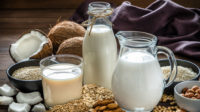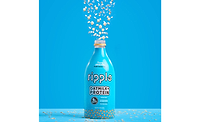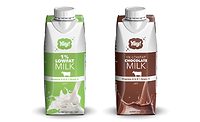Dairy drinks and alternatives market fluctuates
Consumers opt for dairy, non-dairy beverages for various reasons

Image courtesy of Califia Farms
In the introduction for the Disney channel series “Hannah Montana,” the song “Best of Both Worlds” tells the story of how a girl lives a double life. She is a regular teen by day, going to school and doing normal teenager activities, but a pop star by night, riding in limos and wearing the latest fashions.
“The best of both worlds” is how Julia Mills, food and drink analyst at Mintel, Chicago, describes consumers’ view of dairy and non-dairy milk in Mintel’s August executive summary report titled “Milk and Non-Dairy Milk – US, 2024.”
The report notes that the sales of both dairy and non-dairy milk beverages are steady.
“Sales of both dairy and non-dairy milk are expected to stabilize as consumers seek to satisfy their varied needs by choosing products from both segments,” it states. “Enhanced production techniques and formulations for both types of milk are anticipated to continue driving the category’s growth.”
Milk has remained a staple in households, even if the types chosen have changed as consumers see the benefits of both dairy and non-dairy options, the report adds.
“Neither will disappear, shifts in consumption will continue, driven by health, environmental sustainability and personal diet choices,” it reads.
Mintel’s report also notes that brands have blended minimalism and maximalism in innovation.
“Dairy and non-dairy brands navigate the innovation spectrum,” it states. “Some prioritize health benefits, offering high-protein options or added flavors, while others focus on minimalism, featuring new additives and simple ingredients.”
Both approaches can succeed, the report suggests, but the benefits must be clearly communicated. Mintel’s summary notes that the dairy milk category has experienced little change. The category is consistent thanks to its familiarity and health benefits, but its sales have felt shifts in consumer interest in alternatives.
Mintel estimates that the value change of dairy milk sales over 2023 and 2024 will decrease by 1.2%.
“When selecting dairy milk, consumers weigh multiple factors, with price as the primary consideration, highlighting the importance of value,” the report states. “Nevertheless, distinctive attributes like health benefits or longer shelf life can justify a higher price for some consumers and make brands stand out on-shelf.”
The summary also notes that consumers’ values have shifted and boosted specialty milks.

“Consumers are more willing to invest in milk that fits their personal values and lifestyle choices,” it notes. “Improved financial situations combined with a changing outlook on health, wellness and sustainability largely drive this trend. This shift has spurred a growing demand for premium, specialty milks, such as grass-fed and high-protein.”
John Rodwan, editorial director at Wintersville, Ohio-based Beverage Marketing Corporation (BMC), says that the decline of fluid milk volume is a long-standing tradition. The segment declined in 2023 and is expected to this year as well, he notes.
“Volume fell below 5 billion gallons for the first time in memory in 2022 and has edged downward subsequently,” Rodwan shares. “Per capita consumption stood just above 14 gallons in 2023 — down by almost 2 gallons from five years earlier. Sales did increase, reflecting the pricing environment.”
Dairy beverages face a multitude of challenges, he adds.
“To a large extent, milk has lost its image as the quintessential healthy, wholesome beverage,” Rodwan explains. “Plenty of other beverages offer the calcium and vitamins milk contains. Developments in dairy and alternatives increasingly make them viable substitutes for milk where milk-like liquid remains sought-after, such as in coffee drinks.”
John Crawford, senior vice president of client insights and dairy at Circana, Chicago, expresses that the liquid dairy market has faced the same challenges as the rest of the food and beverage space.
“Driving growth through volume is a challenge when consumers are cutting back,” he says. “Plant-based products struggle due to higher prices, taking pricing later than dairy and widening the gap as dairy prices have eased.”
Acknowledging alternatives
Still, BMC’s Rodwan notes that dairy alternatives remain a small and niche beverage segment, with volume less than one-tenth that of conventional milk.
“Moreover, dairy alternative beverage volume declined for a second year in a row in 2023 (though, as with most beverages, dollars sales nonetheless grew),” he says.
Over the last couple of decades, consumers’ preferred dairy alternatives have shifted a number of times, with soy once standing as the clear leader, but subsequently displaced by other plant-based options.
Innovation and new flavors or types of beverages drive development in the dairy alternative space, Rodwan suggests.
“Over the last couple of decades, consumers’ preferred dairy alternatives have shifted a number of times, with soy once standing as the clear leader, but subsequently displaced by other plant-based options,” he adds.
Rodwan says that almond milk now stands “by far and away” as the largest dairy alternative type by volume, with nearly 70% of the total as of 2023.
“Oat milk, which had a double-digit market share and stands in second place, is well ahead of soy,” he shares. “In both cases, almond and oat beverages offer taste profiles and mouthfeel more palatable to consumers than soy, which never generated much enthusiasm among those seeking an alternative to milk.”
And just as almond and oat beverages once enjoyed rapid growth, Rodwan states that coconut milk is ascending and could potentially move up in the volume and dollar rankings.
“Again, however, what tends to happen with dairy alternatives is that certain segments wax while others wane, and the category itself tends to stagnate,” he says. “Beverage Marketing Corporation expects overall dairy alternative beverage volume to decline in 2024 and for the next several years, even as select segments — especially coconut milk — grow vigorously.”
Circana’s Crawford shares the following as the top-growing substantial claims in each dairy alternative beverage category:
- Dairy milk: prebiotic/probiotic, protein, lactose free
- Creams/creamers: natural sweetener, no added sweetener, non-GMO
- Yogurt: no/low/less sugar, no added sweetener, prebiotic/probiotic
Crawford predicts dairy beverage will return to normal, with alternatives continuing to face challenges.
“Expect dairy to continue to grow at low rates in dollars and volume as growth returns to semi-normalcy, similar to 2019 rates,” he says. “Plant is expected to continue to decline, but at slower rates, eventually returning to flat growth.”
Mintel’s summary report notes that non-dairy milk has made slow gains, because consumers still place value in dairy milk, but appreciate the benefits of both.
“The excitement and demand for non-dairy milk may have reached a peak, but the category will continue to grow as consumers persist in seeking alternative options for variety,” it states.
The report estimates that the market size of non-dairy milk in 2024 will reach $3.7 billion, a decrease of minus 1.8% over the course of 2023 through 2024.
“In a saturated market, consumers gravitate toward simplicity — straightforward ingredients and uncomplicated production processes,” the report states. “Dairy and alternative milks that showcase their natural qualities and highlight their intrinsic health and taste advantages will attract significant interest.”
Mintel also points out that older buyers value function, while younger consumers crave variety.
“Generational differences influence buying behaviors and preferences of non-dairy milk,” the report states. “Older consumers prioritize functional aspects like shelf-life, and tend to prefer more neutral flavors. Alternatively, younger consumers are more adventurous, seeking diverse flavors and health benefits that these alternatives offer.”
Going forward, Mintel suspects that environmental changes will influence the production of both dairy and non-dairy milks.
“Brands will need to innovate, adopt strategies such as carbon-neutral farming, move to powdered formulas to cut down water and plastic use, or even explore lab-grown milk to reduce reliance on traditional farming,” the report says.
Looking for a reprint of this article?
From high-res PDFs to custom plaques, order your copy today!






